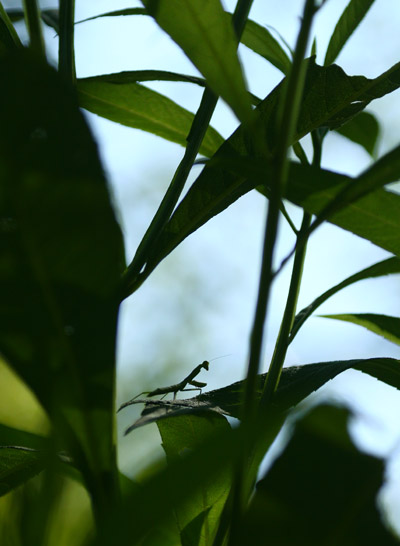 In the past week, I shot about 600 images in four sessions or so, which partially explains the lack of posts. So we’ll play catch-up over a couple of days, and in the process see the difference in approach used, depending on the subject and circumstances.
In the past week, I shot about 600 images in four sessions or so, which partially explains the lack of posts. So we’ll play catch-up over a couple of days, and in the process see the difference in approach used, depending on the subject and circumstances.
For instance, in meetings with students, most times I’m not shooting at all, concentrating instead on instruction. However, in some cases I do working photo outings where I will do some shooting – usually about half as much as the student – but still won’t go whole hog. The most noticeable difference in the resulting images is that I’m usually not carrying the serious macro rig, which consists of two different macro lenses and a bulky lighting unit: flash bracket, mini-ballhead supporting a flat-panel flash, and specially-made softbox. The results from this rig are quite nice, but it’s awkward to carry around and takes a lot of time to set up and pack away. So I’m usually shooting in natural light, which means a much larger aperture than the typical f11 to f22. This means images with lower contrast and less saturation from the lack of a dedicated light, and significantly shorter depth-of-field. It also means, very often, a slower shutter speed, which combined with the short depth means a lot of images to toss out, not quite passing muster.
And since detail is not the most dependable of traits in such circumstances, and it’s not cool to sit down for long periods and do a sequence of behavior, the images tend more towards the fartsy end (not to be confused with artsy.)
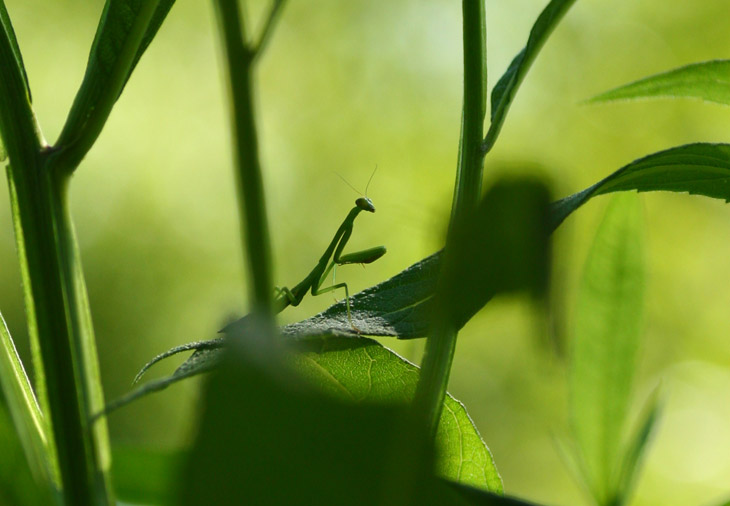
So with this surprisingly small (for this time of year) Chinese mantis, a species that I apparently cannot escape even if I wanted to, I took a couple of different approaches, and in fact this green image was originally shot vertically, but I went for a tighter crop for blog usage and changed it to horizontal. With both, however, the deep shadow it was posing within wasn’t going to allow for a lot – I would have had to compensate exposure by at least +1.3 or 1.7 because the exposure meter could not read a subject that small, but then everything else would have been bleached out very bright. So I aimed for silhouette instead, picking angles that sharply outlined the mantis with bright contrast.
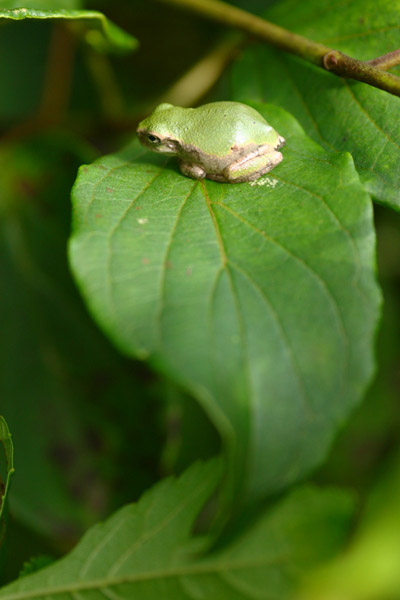 I have a few images of this eentsy treefrog that show the face better, but this one gives a dramatic impression of scale with the entire leaf visible. This is likely a squirrel treefrog (Hyla squirella,) and probably the same species captured exactly three years ago (from the date the images were taken, anyway,) but bigger than that one. Soon afterward, wary of the attention and the heat of the morning sun, the frog elected to delve deeper into the foliage and disappear.
I have a few images of this eentsy treefrog that show the face better, but this one gives a dramatic impression of scale with the entire leaf visible. This is likely a squirrel treefrog (Hyla squirella,) and probably the same species captured exactly three years ago (from the date the images were taken, anyway,) but bigger than that one. Soon afterward, wary of the attention and the heat of the morning sun, the frog elected to delve deeper into the foliage and disappear.
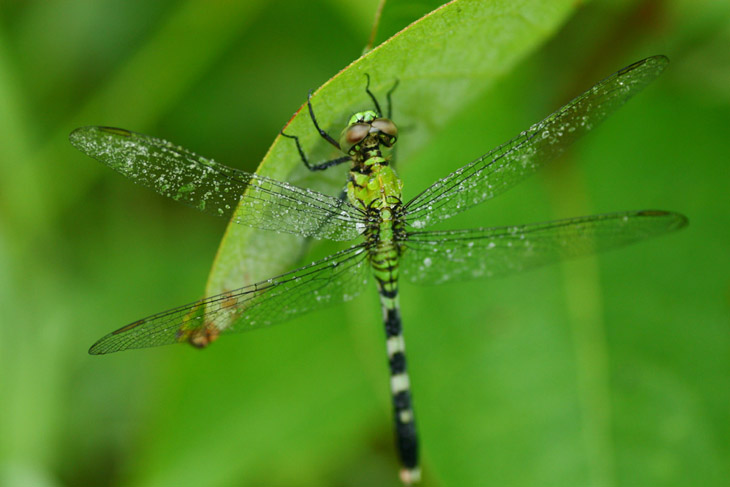
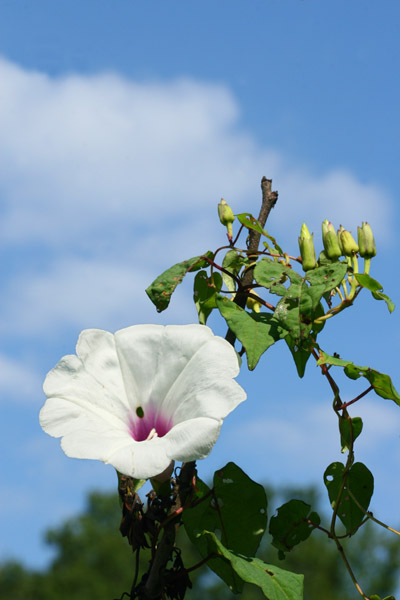 This dragonfly, an eastern pondhawk (Erythemis simplicicollis,) was the first species captured that day, before the sun had risen enough to break through most of the trees and evaporate off the dew – while I admit to plying a misting bottle in situations where it can add to the image, the moisture here is natural, and fairly common with dragonflies in the right conditions. And since dragonflies need a good level of warmth in their wing muscles along the thorax to fly (the reason why they’re always found perching on reeds in bright sunlight,) any this covered in dew are unlikely to fly away at a close approach. However, with a very slow approach, you can actually get them to perch on a fingertip at any time, because they view speed as a threat and glacial movements simply don’t register in this way. Go straight in towards the head, and gently push up against the face or forelegs when you make contact – no, they don’t bite.
This dragonfly, an eastern pondhawk (Erythemis simplicicollis,) was the first species captured that day, before the sun had risen enough to break through most of the trees and evaporate off the dew – while I admit to plying a misting bottle in situations where it can add to the image, the moisture here is natural, and fairly common with dragonflies in the right conditions. And since dragonflies need a good level of warmth in their wing muscles along the thorax to fly (the reason why they’re always found perching on reeds in bright sunlight,) any this covered in dew are unlikely to fly away at a close approach. However, with a very slow approach, you can actually get them to perch on a fingertip at any time, because they view speed as a threat and glacial movements simply don’t register in this way. Go straight in towards the head, and gently push up against the face or forelegs when you make contact – no, they don’t bite.
And we needed a break from the green in the middle, so here’s a morning glory blossom against the blue sky. I also have variations taken from a slightly different angle that eliminated the clouds, presenting a perfectly blue sky, but I favor this one. Naturally, it took a lower shooting angle than standing holding the camera at eye-level.
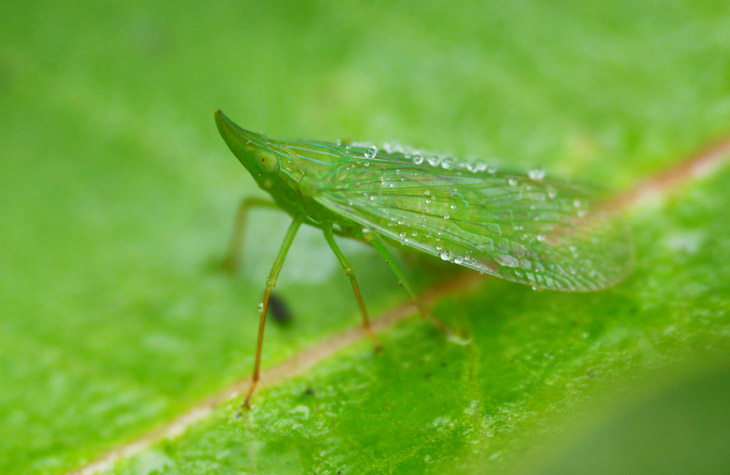
Another early dew shot, this time of a small planthopper, genus Rhynchomitra. By the way, leafhoppers look like leaves or buds, while planthoppers look like thorns – just so you know. I admit to this being a shamelessly ‘shopped photo, but that’s not the politically correct way of putting it anymore, so now I have to call it a ‘stacked’ image. At f4, I did not get an image where both the eyes and the dewdrops on the wings were in focus at the same time, but I got images with either, so two were combined to make this frame. In order to do something like this, though, the shots used need to be as similar to each other as possible – no changes in perspective or focal length or exposure. This is where shooting several images of a tricky subject can come in handy, especially handheld where sharp focus can be altered by your own breathing.
In fact, there is another stacked image in this post – see if you can determine which it is.
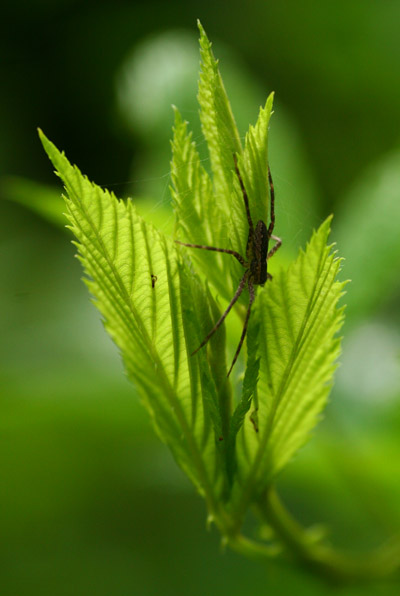 The dew had already boiled off by the time we found several nursery web spiders (Pisaurina mira,) all perched in similar positions atop their own stalks of raspberry plants. To me, there’s something evocative of the early morning sunlight shining through yet the spider appears to be shunning it. While this is likely true, because it will help them avoid birds, I cannot say this definitively, especially since we only had the one angle to work from, so couldn’t test the theory by finding any others on the sunny side of the plants.
The dew had already boiled off by the time we found several nursery web spiders (Pisaurina mira,) all perched in similar positions atop their own stalks of raspberry plants. To me, there’s something evocative of the early morning sunlight shining through yet the spider appears to be shunning it. While this is likely true, because it will help them avoid birds, I cannot say this definitively, especially since we only had the one angle to work from, so couldn’t test the theory by finding any others on the sunny side of the plants.
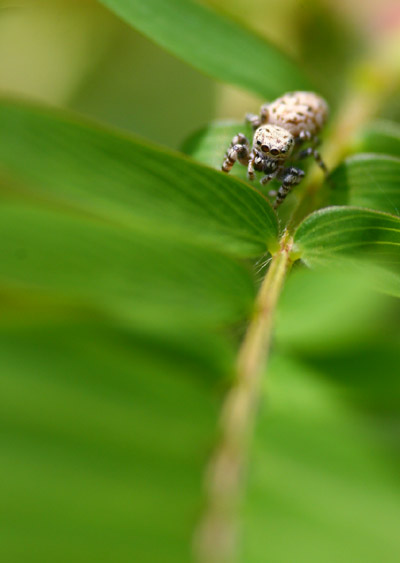 We close with another spider, this one a jumping spider, likely genus Pelegrina judging from the markings on the abdomen (seen much better in another image.) I had initially identified the plant it was on as a mimosa, but then found that a similar-looking plant with yellow flowers nearby was a partridge pear, so don’t trust me. Once again, framing for a more fartsy look than for identification, or behavior, or anything else, so I waited for the spider to turn and face me, which also caused it to line up with the plant stem and generate a little cohesiveness in doing so. The framing left space below it, accentuating both its diminutive size and isolation. It may have been better from the other side, having the spider face into the light and perhaps generating an image where it was looking up instead of down, but the thick undergrowth meant even attempting this would have spooked the spider away because of the movement of the plants, so this is what we have. It’s one of those things I consider constantly: not just, “Is it good?” but, “How can it be better?” At times this can be a little discouraging, especially if you feel that you missed an opportunity or ‘blew’ the shot, but it also makes you think about the image and always try to top it, which is no bad thing. Any one of the images in this post could be better, and who knows how many I would use in, for instance, a gallery exhibit, but these are illustrating just one outing, and not even a dedicated one at that since it was with a student. I have enough keepers from the session that I’m satisfied.
We close with another spider, this one a jumping spider, likely genus Pelegrina judging from the markings on the abdomen (seen much better in another image.) I had initially identified the plant it was on as a mimosa, but then found that a similar-looking plant with yellow flowers nearby was a partridge pear, so don’t trust me. Once again, framing for a more fartsy look than for identification, or behavior, or anything else, so I waited for the spider to turn and face me, which also caused it to line up with the plant stem and generate a little cohesiveness in doing so. The framing left space below it, accentuating both its diminutive size and isolation. It may have been better from the other side, having the spider face into the light and perhaps generating an image where it was looking up instead of down, but the thick undergrowth meant even attempting this would have spooked the spider away because of the movement of the plants, so this is what we have. It’s one of those things I consider constantly: not just, “Is it good?” but, “How can it be better?” At times this can be a little discouraging, especially if you feel that you missed an opportunity or ‘blew’ the shot, but it also makes you think about the image and always try to top it, which is no bad thing. Any one of the images in this post could be better, and who knows how many I would use in, for instance, a gallery exhibit, but these are illustrating just one outing, and not even a dedicated one at that since it was with a student. I have enough keepers from the session that I’m satisfied.




















































